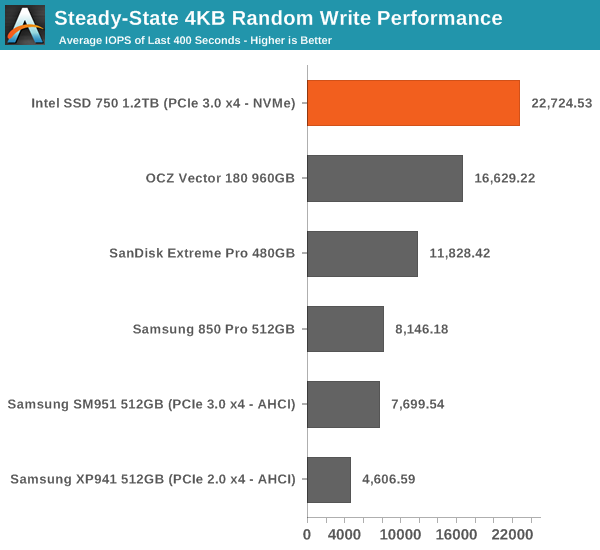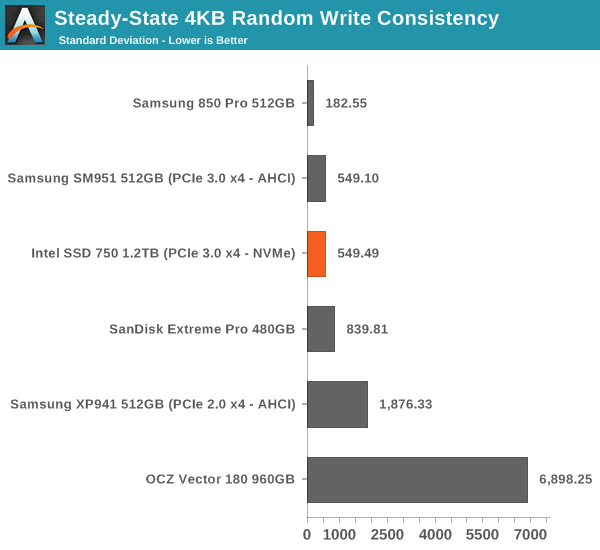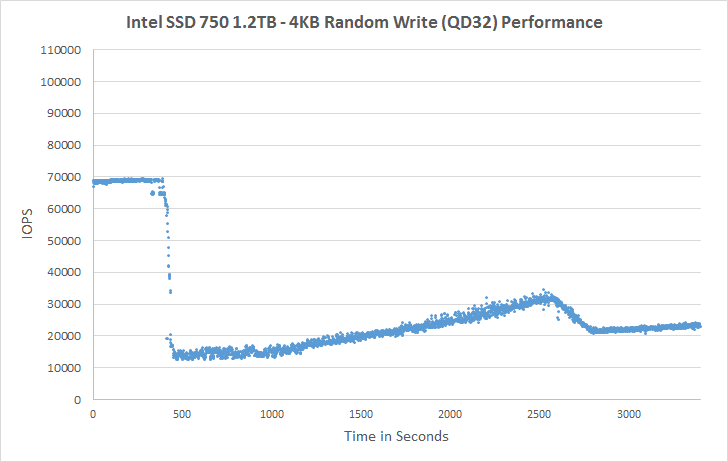Intel SSD 750 PCIe SSD Review: NVMe for the Client
by Kristian Vättö on April 2, 2015 12:00 PM ESTPerformance Consistency
We've been looking at performance consistency since the Intel SSD DC S3700 review in late 2012 and it has become one of the cornerstones of our SSD reviews. Back in the days many SSD vendors were only focusing on high peak performance, which unfortunately came at the cost of sustained performance. In other words, the drives would push high IOPS in certain synthetic scenarios to provide nice marketing numbers, but as soon as you pushed the drive for more than a few minutes you could easily run into hiccups caused by poor performance consistency.
Once we started exploring IO consistency, nearly all SSD manufacturers made a move to improve consistency and for the 2015 suite, I haven't made any significant changes to the methodology we use to test IO consistency. The biggest change is the move from VDBench to Iometer 1.1.0 as the benchmarking software and I've also extended the test from 2000 seconds to a full hour to ensure that all drives hit steady-state during the test.
For better readability, I now provide bar graphs with the first one being an average IOPS of the last 400 seconds and the second graph displaying the standard deviation during the same period. Average IOPS provides a quick look into overall performance, but it can easily hide bad consistency, so looking at standard deviation is necessary for a complete look into consistency.
I'm still providing the same scatter graphs too, of course. However, I decided to dump the logarithmic graphs and go linear-only since logarithmic graphs aren't as accurate and can be hard to interpret for those who aren't familiar with them. I provide two graphs: one that includes the whole duration of the test and another that focuses on the last 400 seconds of the test to get a better scope into steady-state performance.

Given the higher over-provisioning and an enterprise-oriented controller, it's no surprise that the SSD 750 has excellent steady-state random write performance.

The consistency is also very good, although the SSD 750 can't beat the 850 Pro if just focusing on consistency. When considering that the SSD 750 provides nearly three times the performance, it's clear that the SSD 750 is better out of the two.
 |
|||||||||
| Default | |||||||||
At the initial cliff the performance drops to around 15K IOPS, but it quickly rises and seems to even out at about 22-23K IOPS. It actually takes nearly an hour for the SSD 750 to reach steady-state, which isn't uncommon for such a large drive but it's still notable.
I couldn't run tests with added over-provisioning because NVMe drives don't support the usual ATA commands that I use to limit the LBA of the drive. There is similar command set for NVMe as well, but I'm still trying to figure out how to use them as there's isn't too much public info about NVMe tools.
 |
|||||||||
| Default | |||||||||










132 Comments
View All Comments
mmrezaie - Thursday, April 2, 2015 - link
finally it has started, although I wont budge now. maybe next generation.blanarahul - Thursday, April 2, 2015 - link
Hey Kristian, I read that the 1.2 TB model uses 84 dies. But that's not a multiple of 18. So what gives? Is it running in 14 channel mode or something?blanarahul - Thursday, April 2, 2015 - link
Okay so it has 86 dies. But now it's even more confusing. Aren't they supposed be multiples of number of channels the controller is using?SunLord - Thursday, April 2, 2015 - link
Its likely 18 channels so 4 probably only address 4 dies while the 14 other channels handle 5woggs - Thursday, April 2, 2015 - link
yepTyrDonar - Friday, April 10, 2015 - link
Controllers don't have to operate on a specific multiple of the number of dies. That's just a coincidence as to how we've seen them so far on most SSD's. They can operate with varying priorities and asymmetrically. Further, more than 1 channel can address the same die in different intervals/priorities. As controllers become more and more complex, this kind of assymetrical operation will become more common, unfortunately this is correlated with increasing number of total dies and lower reliability.huaxshin - Thursday, April 2, 2015 - link
Will there be any M2 SSDs from Intel with NVMe? Some notebooks, and desktops, have routed PCIe to M2 slots where its the only place its available.blanarahul - Thursday, April 2, 2015 - link
No.DigitalFreak - Thursday, April 2, 2015 - link
Not with this controller. Maybe down the road.bgelfand - Thursday, April 2, 2015 - link
I suspect this drive is not for the current z97 chip set, but will realize its potential with the Z170 chipset (Sunrise Point) due for release in the second half of this year with Skylake. The Z170 chipset has 20 PCIe 3.0 lanes and DMI 3.0 (8 GB/s) bus interface.It should be a very interesting second half of the year - Skylake CPU, Sunrise Point chipsets, and Windows 10.